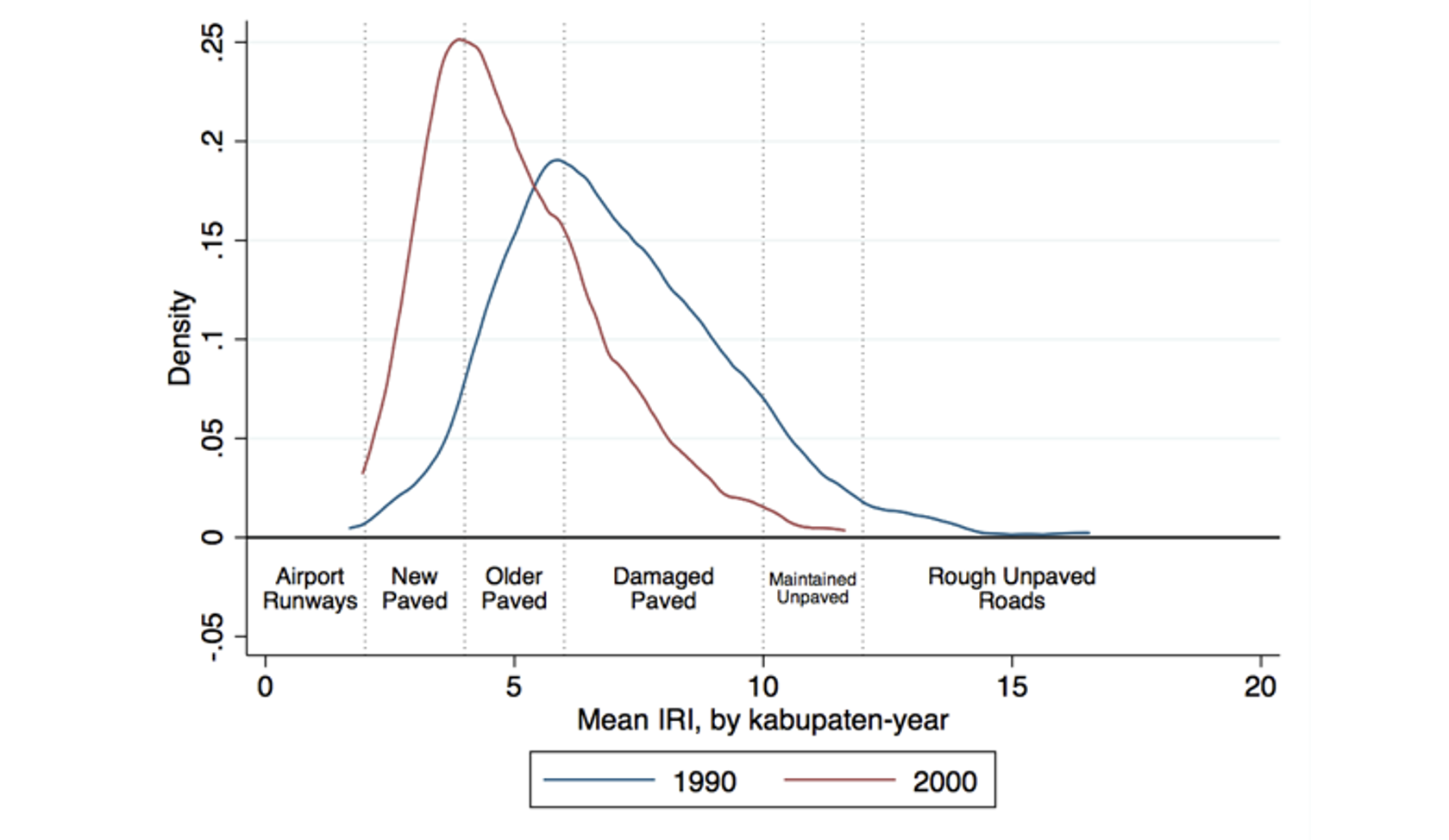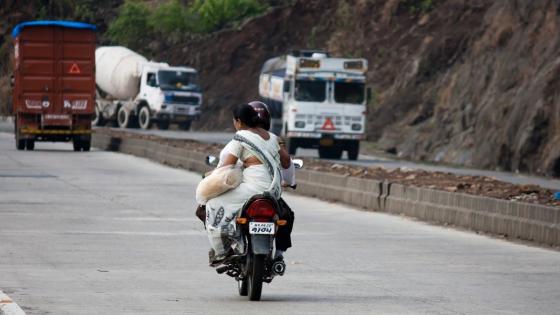Adequate transport infrastructure is essential for economic development and growth. By facilitating the movement of goods and people across locations, road networks can increase regional trade, integrate goods markets, stimulate output growth, and raise economic welfare (Donaldson 2015). There is a growing body of evidence which estimates the different impacts of newly created transport infrastructure links, including studies of large projects such as China’s new national trunk roads (Banerjee et al. 2020, Faber 2014), new railways in colonial India (Donaldson 2018), or highways in the US (Duranton and Turner 2012). However, there is little evidence on the benefits of maintaining and upgrading those road investments.
This lack of evidence is unfortunate given that the largest share of road investment is typically allocated to repaving and resurfacing existing roads. Policymakers also often justify maintenance expenditure as a public good investment to stimulate economic activity and create jobs. The effects of smoother surfaces and the faster speeds they allow, could be particularly important in countries where transportation costs are high, infrastructure budgets are tight, and roads deteriorate rapidly due to tropical climate conditions (Robinson and Thagesen 2017).
Road maintenance investments in Indonesia
To help fill this gap in the literature, in Gertler et al. (2022) we analyse how changes in road quality driven by maintenance and upgrading decisions impact local economic outcomes in Indonesia. The basis of our analysis is a long and comprehensive administrative dataset measuring road roughness for all Indonesian highways collected by Indonesia’s Ministry of Public Works and Housing between 1990 and 2007. Road quality is measured using the International Roughness Index (IRI), which is the sum of vertical displacement of a vehicle as it traverses a road at a constant speed. This measure is especially useful for developing countries since it can capture roughness in both paved and unpaved roads and can distinguish between dirt roads of differing quality. Figure 1 plots the distribution of average road quality across Indonesia’s districts in two years of our sample (1990 and 2000). It shows the range of road quality present in Indonesia – from rough unpaved roads to airport runway quality pavement. Our data source for economic development outcomes is the Indonesia Family Life Survey (IFLS), a nationally representative panel of households and communities that tracks more than 30,000 individuals in five waves over a 22-year period (1993-2015). For firm level outcomes we make use of several waves of Indonesia’s Manufacturing Census.
Figure 1 Changes in the distribution of road roughness
A challenge in obtaining causal estimates of the effects of road improvements is that policymakers often target areas selectively for upgrades based on political characteristics or economic trajectories (Blimpo et al. 2013, Burgess et al. 2015, Asher and Novosad 2020). Indeed, over the period we study, Indonesian authorities tended to target maintenance investments towards upgrading the lowest quality roads. As a result, naïve estimates of the relationship between road quality and economic outcomes are downward biased.
To overcome this causal inference challenge, we take advantage of Indonesia’s two-stage budgeting process for road financing. In the first stage, the central government sets an annual total budget for road maintenance. This common pool is subsequently allocated to provincial decision-making units based on strict budget distribution formulas that depend on provincial observable characteristics. In the second stage, provincial authorities use these allotted funds to upgrade their choice of roads across districts.
The second stage is where the selection-bias lies, as local road authorities, or local branches of national Ministry of Public Works and Housing, decide where to make road investments. However, we can use first-stage provincial allocations as local road quality instrumental variables to identify causal effects.
Estimating the effects of road maintenance
To estimate the welfare effects of road quality, we use a framework that allows us to decompose the different channels through which road quality can affect household welfare. These channels are: (1) wage income; (2) firm profits; and (3) local prices. We first obtain causal estimates of the effect of road quality on each of these outcomes, and then combine them using our framework to estimate overall household welfare effects.
We find that when road quality improves, nominal income and consumption expenditures increase significantly. We estimate that a 10% increase in road quality leads to a 2% increase in per-capita consumption in a district. Interestingly, the observed increase in consumption expenditures is driven not by more hours worked or a higher likelihood of being employed, but rather by workers shifting their occupation out of informal employment (including agriculture) and into higher-wage manufacturing and other formal jobs.
We verify that this formal manufacturing sector employment result holds using panel data on manufacturing firms. We corroborate that better road quality is reflected in higher total value added, output, and employment from manufacturing firms at the district level, and that output per worker increases.
To address concerns that these estimates reflect displacement effects in which road quality acts as a coordinating device attracting firms that were going to be created regardless of road quality, we show that the increase in the number of firms and employment is not driven by footloose, foreign-owned manufacturing firms, nor is it simply due to displacement of other firms from nearby districts. This suggests that our results represent genuine growth effects instead of a reshuffling of economic activity.
Unlike the labour effects documented above, our estimates of the impact of road quality on household-owned business profits (farm and non-farm) are positive but not statistically significant. Regarding cost of living, we find that road improvements reduce the price of perishable food products, but do not affect prices of non-perishable goods. Road improvements also generate higher land values and rents, consistent with road quality being valued as a productive amenity.
Armed with these well-identified estimates of the different impacts of road quality, we combine them using our framework to obtain overall household welfare effects. We find that a 10% increase in road quality increases household welfare by 1.6% on average. Most of these positive welfare effects are attributable to increases in labour income that are driven by the growth of formal employment opportunities.
Finally, we use our welfare estimates to conduct a cost-benefit analysis of different hypothetical road maintenance policies. For illustration, we analyse the effect of upgrading all of a district’s highways to high quality pavement. For the median district, there is a positive stimulus benefit of these upgrades that lasts for an average of six years before deterioration erodes road quality back to its initial levels. We estimate that an upgrade of this type would deliver a stream of welfare benefits equal to 2.8 times their costs.
Policy implications
Our work shows that the quality of highways is an important determinant of household welfare. Higher quality roads enable firms to be created in locations that were previously uneconomical for production. This provides employment opportunities that encourage workers to transition out of informal employment, raising their incomes.
Recent transport spending in developing countries has largely been pro-cyclical (Foster et al. 2022). This is unfortunate given that the economic boost provided by government spending tends to be largest during recessions (Auerbach and Gorodnichenko 2012). Our findings suggest that governments should take into account the impacts of road maintenance investments on household welfare when setting priorities for transportation budgets. It also demonstrates that policymakers can use these investments as a counter-cyclical fiscal policy tool.
Editors' note: This column has also appeared on VoxDev. A discussion of the key takeaways from this research is available as a podcast here.
References
Auerbach, A J and Y Gorodnichenko (2012), “Measuring the output responses to fiscal policy”, American Economic Journal: Economic Policy 4(2): 1–27.
Asher, S and P Novosad (2020), “Rural roads and local economic development”, American Economic Review 110(3): 797–823.
Banerjee, A, E Duflo, and N Qian (2020), “On the Road: Access to Transportation Infrastructure and Economic Growth in China”, 145: 102442.
Bird, J and S Straub (2020), “The Brasilia experiment: the heterogeneous impact of road access on spatial development in Brazil”, World Development 127: 104739.
Blimpo, M P, R Harding, and L Wantchekon (2013), “Public investment in rural infrastructure: Some political economy considerations”, Journal of African Economies 22, ii57–ii83.
Burgess, R, R Jedwab, E Miguel, A Morjaria, and G Padro I Miquel (2015): “The Value of Democracy: Evidence from Road Building in Kenya”, American Economic Review 105(6): 1817–51.
Donaldson, D (2015), "The Gains from Market Integration", Annual Review of Economics 7(1): 619-647.
Donaldson, D (2018), “Railroads of the Raj: Estimating the Impact of Transportation Infrastructure”, American Economic Review 108(4-5): 899–934.
Faber, B (2014), “Trade Integration, Market Size, and Industrialization: Evidence from China’s National Trunk Highway System”, Review of Economic Studies 81(3): 1046–1070.
Foster, A D and M R Rosenzweig (2004), “Agricultural Productivity Growth, Rural Economic Diversity, and Economic Reforms: India, 1970–2000”, Economic Development and Cultural Change 52(3): 509–542.
Foster, V, A Rana, and N Gorgulu (2022), “Understanding Public Spending Trends for Infrastructure in Developing Countries”, World Bank Policy Research Working Paper 9903.
Morten, M and J Oliveria (2018), “The Effects of Roads on Trade and Migration: Evidence from a Planned Capital City”, NBER Working Paper 22158.
Gertler P, M Gonzalez-Navarro, T Gracner, A D Rothenberg (2022), “Road Maintenance and Local Economic Development: Evidence from Indonesia’s Highways.” NBER Working Paper 30454
Robinson, R and B Thagesen (2017), Road Engineering for Development, London: Taylor & Francis Group.








